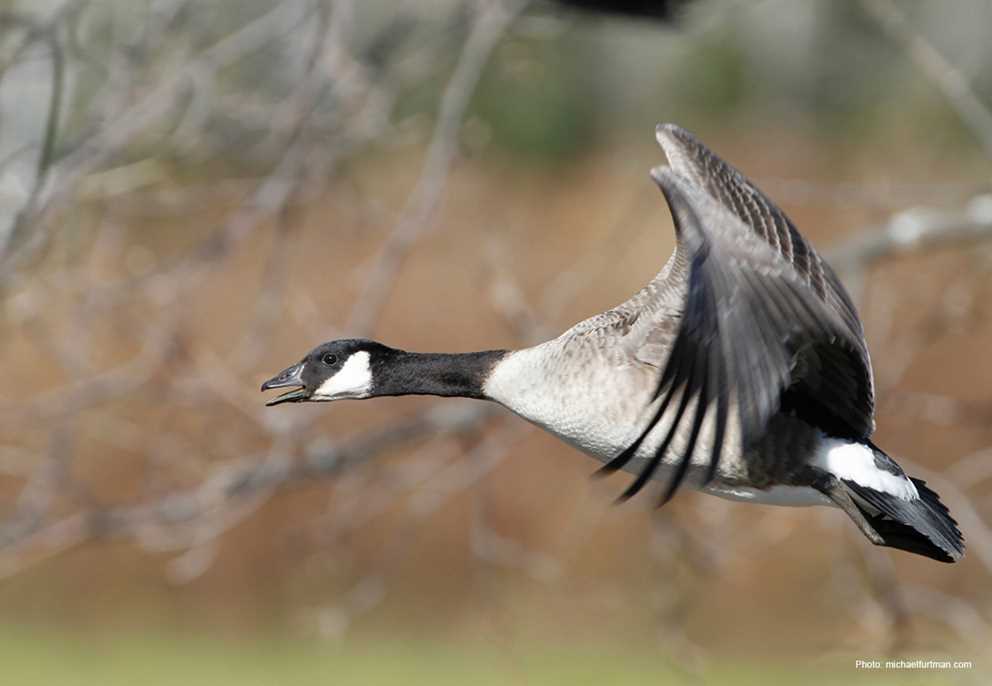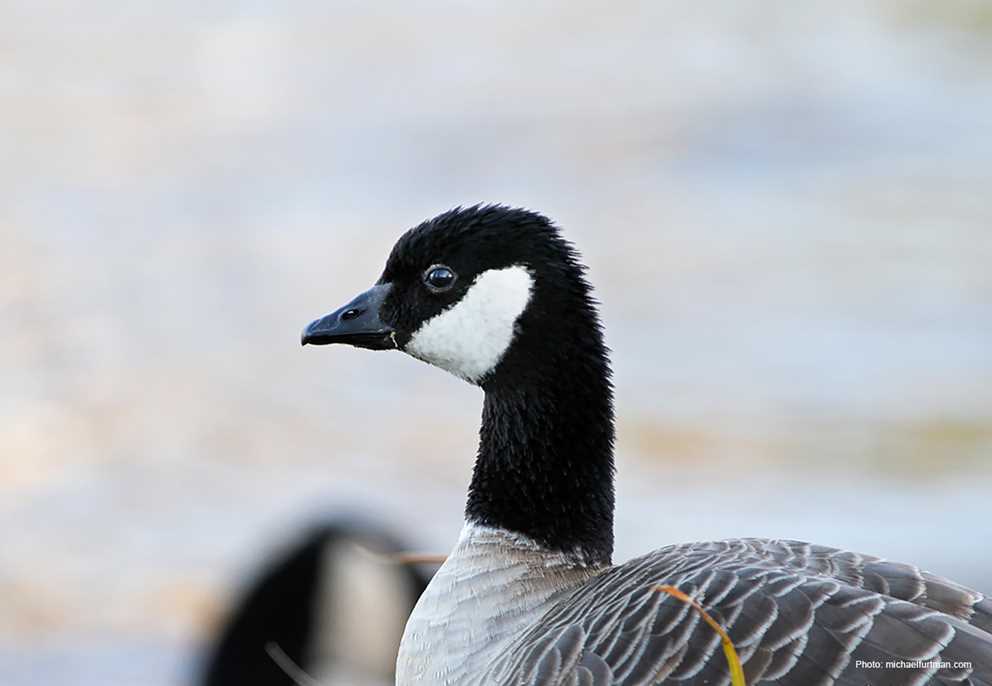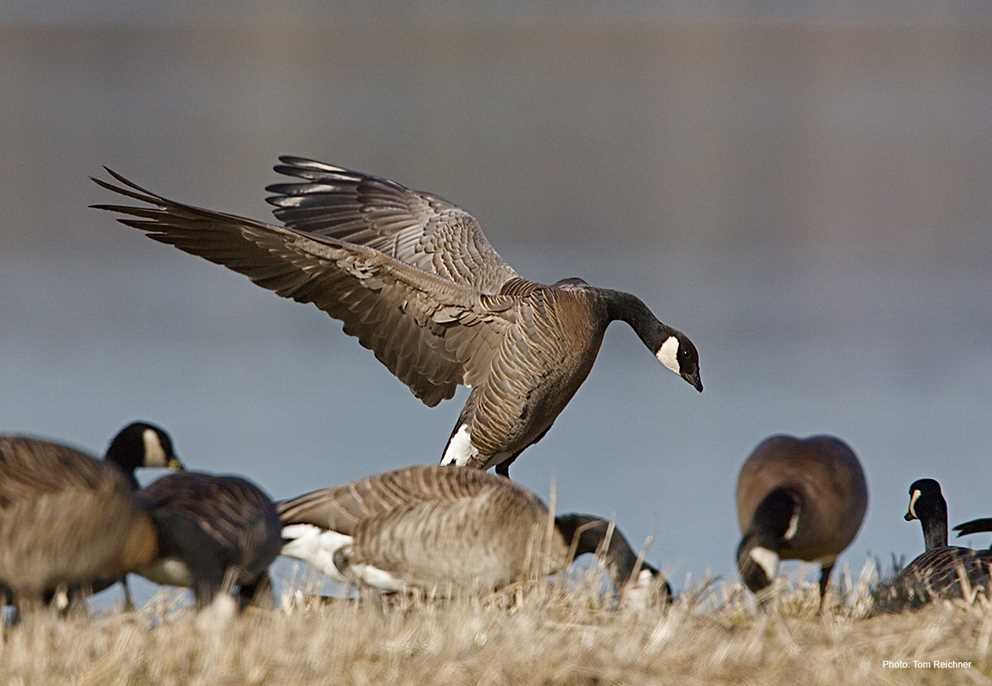Overview
Cackling Geese are endemic to North America. Their breeding range extends from western Arctic Alaska across Arctic Canada to Baffin Island and northwestern Quebec. In the field, they look like a small Canada Goose, with a black head and neck with a distinctive white chinstrap that extends upward on each cheek to behind their eye. The body plumage is grayish-brown, with feathers tipped with light tan, black neck sharply contrasts with gray-brown breast, the rump is blackish, upper tail coverts are white, and the tail is black. The breast, belly, sides, and flanks are gray brown, and the undertail coverts are white. The sexes are identical.
There are four recognized subspecies of Cackling Goose: 1) Richardson’s Cackling Goose (B. h. hutchinsii) that breeds in the Arctic from about the McKenzie River Delta to southern Baffin Island and northwestern Quebec, and historically wintered on the Gulf Coast but now winters mainly in the Southern Great Plains of Colorado, Nebraska, Kansas, Oklahoma, Texas, and New Mexico; 2) Aleutian Cackling Goose (B. c. leucopareia) that breeds in the western and central Aleutian Islands and winters mainly in Central Valley of California ; 3) minima Cackling Goose (B. h. minima) that breeds only in the Yukon-Kuskokwim Delta of western Alaska, and winters in the Willamette Valley and along the Lower Columbia River Valley of western Oregon and Washington, and 4) Taverner’s Cackling Goose (B. h. taverneri) that breeds in Alaska in the Yukon-Kuskokwim Delta, Seward Peninsula, and winter in the Willamette and Lower Columbia River Valleys, with smaller numbers sometimes found in the Southern Great Plains.
Nesting Cackling Geese use islands and margins of lakes and ponds of tundra lakes and ponds, except for Aleutian Cackling Geese, that prefer grassy slopes above cliffs or inland on the islands. Winter and migration habitat includes freshwater and coastal bays, lakes and marshes, and they make extensive use of agricultural fields to forage on waste grains.
Description
Key Identification Features
- In the field, Cackling Geese look like a diminutive form of Canada Geese. With a black head and neck with a distinctive white chinstrap that extends upward on each cheek to behind their eye.
- The body plumage is grayish brown, with feathers tipped with light tan, black neck sharply contrasts with a gray brown breast, the rump is blackish, upper tail coverts are white, and the tail is black. The breast, belly, sides, and flanks are gray brown and the undertail coverts are white.
- There is subtle to notable variation in size and plumage coloration among subspecies, with some showing darker tones overall.
- Both sexes are identical.
Male/Female Average Length and Weight
- Varies among subspecies, B. h. mimima is the smallest, followed by B. h. leucopareia, B. h. hutchinsii, and then the largest subspecies B. h. taverneri.
- Weight: Males 3.8–6.3 lbs.; Females 2.5–5.9 lbs.
- Wingspan: 24.8 in
Male and Female Identification
- Alternate (Breeding) and Basic Plumage: A separate species but very similar in appearance to the Canada Goose, with a black head and neck with a distinctive white chinstrap that extends upward on each cheek to behind their eye. The body plumage is grayish-brown, with feathers tipped with light tan, black neck sharply contrasts with gray brown breast, the rump is blackish, upper tail coverts are white, and the tail is black. The breast, belly sides and flanks are gray brown with white undertail coverts. There is subtle to notable variation in size and plumage coloration among subspecies, with some showing lighter or darker tones overall. The bill, legs and feet are black. The sexes are identical.
In-Flight Identification
- Cackling Geese are roughly the size of Mallard, with coloration similar to that of the Canada Goose. Short-necks are notable when in flight compared to Canada geese.
- In flight, there is a white V or U shape visible above the black tail.
Vocalizations
- Very vocal, especially in flight and in large flocks. Typical sounds are high pitched “hrooonk, honk” similar to Canada Geese but higher pitched.
Similar Species
- Canada Goose: Unique in appearance and unlikely to be confused with any other North American species of goose except for the Canada Goose. Separation in the field is difficult and sometimes not possible, especially with the small Canada Goose subspecies (B. canadensis parvipes).While Cackling Geese are usually smaller than most subspecies of Canada Goose, size alone does not conclusively separate them in the field. Bill length is a useful characteristic with Cackling Geese ranging from 1.1–1.5 in, while Canada Geese range from 1.6–2.3 in. The head and neck characteristics are also useful tools, with the Cackling Goose showing a proportionally shorter neck, and the head is shorter and boxier, with a stubbier bill compared to smaller subspecies of Canada Goose. Cackling and Canada Geese both have distinctive white cheek patches that easily distinguish them from Brant.
Habitat Preferences
- Breeding: Cackling Geese nest on islands or shorelines of Artic Lakes, ponds and river deltas, except for Aleutian Cackling Geese that prefer south facing grassy slopes above coastal cliffs or inland on the islands.
- Migration and Wintering: Wintering and migration habitat includes marshes, coastal wetlands, pastures, and agricultural fields.
Foraging Habits and Diet
- Cackling Geese are mostly herbivorous and eat a variety of seeds, leaves, berries, roots and rhizomes of numerous grasses, sedges, and some herbaceous plants. In addition, they have adapted well to foraging waste grain and winter cereal crops in migration and wintering areas. They feed by grazing, tipping up, grubbing for roots, and picking seeds and waste grain.
Breeding Habits
- Monogamy: Cackling Geese maintain monogamous, usually long-term pair bonds, with birds repairing after death of a mate.
- Nest Locations: The nest is usually a depression created by the female, with vegetation and down added as laying progresses.
- Clutch Size: Average clutch size is 3 to 6 eggs with some variation among subspecies. The eggs are creamy white to pale tan-white, elliptical to ovoid. The incubation period is approximately 26 to 27 days, with females performing incubation duties. Males provide nest defense.
Migration and Distribution
- Timing of migration varies among subspecies.
- Fall Migration: High artic nesters depart in late August or September for staging areas and usually arrive in wintering areas in October or November.
- Spring Migration: Spring migration may begin in February for some subspecies or subpopulations, with arrivals for high Arctic subspecies from late May or early June.

Conservation Status
- IUCN Status: Least Concern
- Population Status: The global population of Cackling Geese is estimated to be around 3,000,000, of which 2,499,000 are B. h. hutchinsii, 205,000 are B. h. minima, 199,000 are B. h. leucopareia, and 59,000 are B. h. taverneri. Population trends suggest slight declines in recent years.
- Conservation Concerns: The primary threats include habitat loss, pollution, and climate change.
- Conservation Focus: Conservation efforts focus on monitoring Cackling Goose populations, managing predators, and protecting crucial nesting and wintering habitat.
Harvest Information
- An average of 157,863 Cackling Geese were harvested per season across the US during the 2021 through 2022 hunting seasons.
- Cackling Goose harvest is typically highest in the Central Flyway, accounting for 60 to 70 percent of the total US harvest.
- The top three states for Cackling Goose harvest, based on annual averages across the 2021–2022 hunting seasons, were Oklahoma (28,671), Colorado (21,934), and Texas (21,696).



